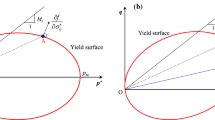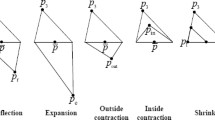Abstract
Soft structured clays usually exhibit complex behaviors, which can lead to difficulties in the determination of parameters and high testing costs. This paper aims to propose an efficient optimization method for identifying the parameters of advanced constitutive model for soft structured clays from only limited conventional triaxial tests. First, a new real-coded genetic algorithm (RCGA) is proposed by combining two new crossover and mutation operators for improving the performance of optimization. A newly developed elastic–viscoplastic model accounting for anisotropy, destructuration and creep features is enhanced with the cross-anisotropy of elasticity and is adopted for test simulations during optimization. Laboratory tests on soft Wenzhou marine clay are selected, with three of them being used as objectives for optimization and others for validation. The optimization process, using the new RCGA with a uniform sampling initialization method, is carried out to obtain the soil parameters. A classic genetic algorithm (NSGA-II)-based optimization is also conducted and compared to the RCGA for estimating the performance of the new RCGA. Finally, the optimal parameters are validated by comparing with other measurements and test simulations on the same clay. All comparisons demonstrate that a reliable solution can be obtained by the new RCGA optimization combined with the appropriate soil model, which is practically useful with a reduction in testing costs.



















Similar content being viewed by others
References
Biarez J, Hicher P-Y (1994) Elementary mechanics of soil behaviour: saturated remoulded soils. AA Balkema, Rotterdam
Calvello M, Finno RJ (2004) Selecting parameters to optimize in model calibration by inverse analysis. Comput Geotech 31(5):410–424. doi:10.1016/j.compgeo.2004.03.004
Chang CS, Yin ZY (2010) Micromechanical modeling for inherent anisotropy in granular materials. J Eng Mech ASCE 136(7):830–839. doi:10.1061/(asce)em.1943-7889.0000125
Chuang Y-C, Chen C-T, Hwang C (2015) A real-coded genetic algorithm with a direction-based crossover operator. Inf Sci 305(1):320–348
Dan HB (2005) Time dependent behavior of natural soft clays. Ph.D. thesis, Zhejiang University, Hangzhou, China
Deb K (2001) Multi-objective optimization using evolutionary algorithms, vol 16. Wiley, New York
Deb K, Agrawal RB (1995) Simulated binary crossover for continuous search space. Complex Syst 9(2):115–148
Deb K, Goyal M (1996) A combined genetic adaptive search (GeneAS) for engineering design. Comput Sci Inform 26(4):30–45
Deb K, Pratap A, Agarwal S, Meyarivan T (2002) A fast and elitist multiobjective genetic algorithm: NSGA-II. IEEE Trans Evol Comput 6(2):182–197
Deep K, Thakur M (2007) A new mutation operator for real coded genetic algorithms. Appl Math Comput 193(1):211–230
Gens A, Nova R (1993) Conceptual bases for a constitutive model for bonded soils and weak rocks. Geotech Eng Hard Soils Soft Rocks 1(1):485–494
Goldberg DE (1991) Real-coded genetic algorithms, virtual alphabets, and blocking. Complex Syst 5(2):139–168
Graham J, Houlsby G (1983) Anisotropic elasticity of a natural clay. Geotechnique 33(2):165–180
Herrera F, Lozano M, Verdegay JL (1998) Tackling real-coded genetic algorithms: operators and tools for behavioural analysis. Artif Intell Rev 12(4):265–319
Holland JH (1992) Adaptation in natural and artificial systems. MIT Press, Cambridge
Javadi A, Farmani R, Toropov V, Snee C (1999) Identification of parameters for air permeability of shotcrete tunnel lining using a genetic algorithm. Comput Geotech 25(1):1–24
Jiang J, Ling HI, Kaliakin VN, Zeng X, Hung C (2016) Evaluation of an anisotropic elastoplastic–viscoplastic bounding surface model for clays. Acta Geotech. doi:10.1007/s11440-016-0471-7
Jin Y, Yin Z, Shen S, Hicher P (2016) Selection of sand models and identification of parameters using an enhanced genetic algorithm. Int J Numer Anal Methods Geomech. doi:10.1002/nag.2487
Jin Y-F, Yin Z-Y, Shen S-L, Hicher P-Y (2016) Investigation into MOGA for identifying parameters of a critical state based sand model and parameters correlation by factor analysis. Acta Geotech. doi:10.1007/s11440-015-0425-5
Karstunen M, Yin ZY (2010) Modelling time-dependent behaviour of Murro test embankment. Geotechnique 60(10):735–749
Kimoto S, Oka F (2005) An elasto-viscoplastic model for clay considering destructuralization and consolidation analysis of unstable behavior. Soils Found 45(2):29–42
Lecampion B, Constantinescu A, Nguyen Minh D (2002) Parameter identification for lined tunnels in a viscoplastic medium. Int J Numer Anal Methods Geomech 26(12):1191–1211. doi:10.1002/nag.241
Leroueil S, Kabbaj M, Tavenas F, Bouchard R (1985) Stress–strain–strain–rate relation for the compressibility of sensitive natural clays. Geotechnique 35(2):159–180
Levasseur S, Malécot Y, Boulon M, Flavigny E (2008) Soil parameter identification using a genetic algorithm. Int J Numer Anal Methods Geomech 32(2):189–213. doi:10.1002/nag.614
Michalewicz Z (1992) Genetic algorithms + data structures = evolution programs. Springer, New York
Mokhade AS, Kakde OG (2014) Overview of selection schemes in real-coded genetic algorithms and their applications. J Ind Intell Inf 2(1):71–77
Moreira N, Miranda T, Pinheiro M, Fernandes P, Dias D, Costa L, Sena-Cruz J (2013) Back analysis of geomechanical parameters in underground works using an evolution strategy algorithm. Tunn Undergr Space Technol 33:143–158
Oka F, Takada N, Shimono K, Higo Y, Kimoto S (2016) A large-scale excavation in soft Holocene deposit and its elasto-viscoplastic analysis. Acta Geotech 11:625–642
Pal S, Wije Wathugala G, Kundu S (1996) Calibration of a constitutive model using genetic algorithms. Comput Geotech 19(4):325–348
Papon A, Riou Y, Dano C, Hicher PY (2012) Single-and multi-objective genetic algorithm optimization for identifying soil parameters. Int J Numer Anal Methods Geomech 36(5):597–618. doi:10.1002/nag.1019
Poles S, Fu Y, Rigoni E (2009) The effect of initial population sampling on the convergence of multi-objective genetic algorithms. In: Barichard V, Ehrgott M, Gandibleux X, T'Kindt V (eds) Multiobjective programming and goal programming. Springer, New York, pp 123–133
Pratihar DK (2007) Soft computing. Alpha Science International, UK
Rocchi G, Fontana M, Da Prat M (2003) Modelling of natural soft clay destruction processes using viscoplasticity theory. Geotechnique 53(8):729–745
Rokonuzzaman M, Sakai T (2010) Calibration of the parameters for a hardening–softening constitutive model using genetic algorithms. Comput Geotech 37(4):573–579. doi:10.1016/j.compgeo.2010.02.007
Roscoe KH, Burland JB (1968) On the generalized stress–strain behaviour of wet clay. In: Heyman J, Leckie FA (eds) Engineering plasticity. Cambridge University Press, London, UK, pp 535–609
Sobol IM (1967) On the distribution of points in a cube and the approximate evaluation of integrals. USSR Comput Math Math Phys 7(4):86–112
Vardakos S, Gutierrez M, Xia C (2012) Parameter identification in numerical modeling of tunneling using the differential evolution genetic algorithm (DEGA). Tunn Undergr Space Technol 28:109–123. doi:10.1016/j.tust.2011.10.003
Wang L-Z, Yin Z-Y (2012) Stress dilatancy of natural soft clay under an undrained creep condition. Int J Geomech. doi:10.1061/(ASCE)GM.1943-5622.0000271
Yao YP, Sun DA (2000) Application of Lade’s criterion to Cam–Clay model. J Eng Mech ASCE 126(1):112–119
Yao YP, Hou W, Zhou AN (2009) UH model: three-dimensional unified hardening model for overconsolidated clays. Geotechnique 59(5):451–469
Yao YP, Kong LM, Zhou AN (2015) Time-dependent unified hardening model: three-dimensional elasto-visco-plastic constitutive model for clays. J Eng Mech ASCE 141(6):0414162
Yepes V, Alcala J, Perea C, González-Vidosa F (2008) A parametric study of optimum earth-retaining walls by simulated annealing. Eng Struct 30(3):821–830
Yin ZY, Chang CS (2009) Microstructural modelling of stress-dependent behaviour of clay. Int J Solids Struct 46(6):1373–1388
Yin ZY, Hicher PY (2008) Identifying parameters controlling soil delayed behaviour from laboratory and in situ pressuremeter testing. Int J Numer Anal Methods Geomech 32(12):1515–1535
Yin ZY, Karstunen M (2011) Modelling strain-rate-dependency of natural soft clays combined with anisotropy and destructuration. Acta Mech Solida Sin 24(3):216–230
Yin ZY, Wang JH (2012) A one-dimensional strain-rate based model for soft structured clays. Sci China Technol Sci 55(1):90–100. doi:10.1007/s11431-011-4513-y
Yin ZY, Chang CS, Karstunen M, Hicher PY (2010) An anisotropic elastic-viscoplastic model for soft clays. Int J Solids Struct 47(5):665–677
Yin ZY, Chang CS, Hicher PY (2010) Micromechanical modelling for effect of inherent anisotropy on cyclic behaviour of sand. Int J Solids Struct 47(14–15):1933–1951. doi:10.1016/j.ijsolstr.2010.03.028
Yin ZY, Karstunen M, Chang CS, Koskinen M, Lojander M (2011) Modeling time-dependent behavior of soft sensitive clay. J Geotech Geoenviron Eng 137(11):1103–1113. doi:10.1061/(asce)gt.1943-5606.0000527
Yin Z-Y, Chang CS, Hicher PY, Wang JH (2011) Micromechanical analysis for the behavior of stiff clay. Acta Mech Sin 27(6):1013–1022
Yin Z-Y, Yin J-H, Huang H-W (2015) Rate-dependent and long-term yield stress and strength of soft wenzhou marine clay: experiments and modeling. Mar Georesour Geotechnol 33(1):79–91
Zeng LL (2010) Deformation mechanism and compression model of natural clays. Ph.D. thesis, Nanjing China, Southeast University
Zhu QY, Yin Z-Y, Hicher PY, Shen SL (2016) Nonlinearity of one-dimensional creep characteristics of soft clays. Acta Geotech. doi:10.1007/s11440-015-0411-y
Zitzler E, Thiele L (1998) Multiobjective optimization using evolutionary algorithms—a comparative case study. In: Eiben AE, Bäck T, Schoenauer M, Schwefel H-P (eds) Parallel problem solving from nature—PPSN V. Springer, New York, pp 292–301
Acknowledgments
This research was financially supported by the National Natural Science Foundation of China (Grant Nos. 41372285, 51579179), the European project CREEP (PIAPP-GA-2011-286397). These supports are greatly appreciated. In addition, the authors thank Dr. Li-Zhong Wang, Professor at Institute of Geotechnical Engineering of Zhejiang University, for his support.
Author information
Authors and Affiliations
Corresponding author
Appendix: Anisotropic elastic–viscoplastic model “ANICREEP”
Appendix: Anisotropic elastic–viscoplastic model “ANICREEP”
Based on Yin et al. [49], the main constitutive equations are listed as follows:
where \(\dot{\varepsilon }_{ij}\) denotes the (i, j) component of the total strain rate tensor and the superscripts e and vp represent, respectively, the elastic and the viscoplastic components. The elastic behavior in the proposed model is assumed to be isotropic, as in the modified Cam Clay model. The \(p_{\text{m}}^{\text{d}}\) is the size of the dynamic loading surface. The \(p_{\text{m}}^{\text{r}}\) and \(p_{\text{mi}}\) are the size of the reference and the intrinsic yield surfaces, respectively. The initial reference preconsolidation pressure \(\sigma_{p0}^{{{\prime }{\text{r}}}}\) obtained from an oedometer test can be used as an input to calculate the initial size p m0 using Eq. (14).
The slope of the critical state line M is expressed as follows:
where \(c = (3 - \sin \,\phi_{\text{c}} )/(3 + \sin \,\phi_{\text{c}} )\) according to the Mohr–Coulomb yield criterion (ϕ c is the friction angle); \(- \pi /6 \le \theta = (1/3)\sin^{ - 1} ( - 3\sqrt 3 \bar{J}_{3} /2\bar{J}_{2}^{3/2} ) \le \pi /6\) using \(\bar{J}_{2} = (1/2)\bar{s}_{ij} :\bar{s}_{ij}\), \(\bar{J}_{3} = (1/3)\bar{s}_{ij} \bar{s}_{jk} \bar{s}_{ki}\) with \(\bar{s}_{ij} = \sigma_{\text{d}} - p^{\prime } \alpha_{\text{d}}\).
The model was implemented as a user-defined model in the 2D version 9 of PLAXIS for a coupled consolidation analysis based on Biot’s theory (see details in [49]).
During consolidation coupled analyses, the permeability k varies with void ratio e:
Soil constants and state variables are summarized in Table 8 with their recommended methods of determination (see details in [49]) (Fig. 20).
Rights and permissions
About this article
Cite this article
Yin, ZY., Jin, YF., Shen, SL. et al. An efficient optimization method for identifying parameters of soft structured clay by an enhanced genetic algorithm and elastic–viscoplastic model. Acta Geotech. 12, 849–867 (2017). https://doi.org/10.1007/s11440-016-0486-0
Received:
Accepted:
Published:
Issue Date:
DOI: https://doi.org/10.1007/s11440-016-0486-0





